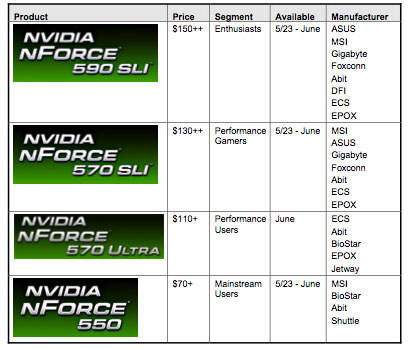NVIDIA's nForce series of chipsets have had a rocky road since their introduction. The original chipset offered innovative features that were not on other AMD Athlon-based chipsets at the time, such as decent integrated graphics and a compelling on-board soundcard under the guise of SoundStorm. It wasn't bad, but it was let down by poor driver support and some design issues in hardware.
Its successor, nForce2, was widely acclaimed as a great enthusiast chipset - with fast performance and an improved design, along with the popular SoundStorm on-board audio solution - it was the first audio solution capable of producing a true Dolby Digital 5.1 output. SoundStorm was dropped when NVIDIA launched nForce3 in conjunction with the launch of AMD's Athlon 64.
The third iteration was something of a let down because it was slower than VIA's K8T800 chipset. nForce3 Ultra improved things somewhat, as it removed many of the performance issues, but VIA responded with the K8T800 Pro. At this point, the two chipsets were neck and neck, with little to choose between the two.
Fast forward to the nForce4-series, which came together with the introduction of NVIDIA's SLI technology. Collectively, the two have been a rip-roaring success, but the chipset didn't come without its problems. One such problem was with NVIDIA's ActiveArmour embedded Firewall, which often caused Windows to crash.
With the release of AMD's AM2 platform today, NVIDIA is unveiling its nForce 500-series chipset (aka nForce 5). It will be adopted, as you'd expect, by all the usual suspects and we will be doing a mainboard group test later this week to determine the best board for your money. In the meantime, we are going to give you a look at the technologies that power the new chipset and how it differs from the very popular nForce4 platform.
 nForce 590 SLI is the all bells all whistles version aimed at the bleeding edge enthusiast; the next step down is nForce 570 SLI and is aimed at performance gamers - both of these chipsets support NVIDIA's SLI technology. The remaining chipsets are single-GPU solutions. nForce 570 Ultra is aimed at the performance-mainstream sector, whilst nForce 550 is aimed at mainstream users and is likely to be paired with either a single core Athlon 64, or even a Sempron chip.
nForce 590 SLI is the all bells all whistles version aimed at the bleeding edge enthusiast; the next step down is nForce 570 SLI and is aimed at performance gamers - both of these chipsets support NVIDIA's SLI technology. The remaining chipsets are single-GPU solutions. nForce 570 Ultra is aimed at the performance-mainstream sector, whilst nForce 550 is aimed at mainstream users and is likely to be paired with either a single core Athlon 64, or even a Sempron chip.
 Obviously, there is clear feature differentiation between the different chipsets. 590 sports many of the features that we might argue make nForce 5, with Linkboost and some of the overclocking features only available on that model. The 550 is completely crippled, and you might as well just have nForce 4 as have the 550. What all those features are is now something we need to explain.
Obviously, there is clear feature differentiation between the different chipsets. 590 sports many of the features that we might argue make nForce 5, with Linkboost and some of the overclocking features only available on that model. The 550 is completely crippled, and you might as well just have nForce 4 as have the 550. What all those features are is now something we need to explain.
Its successor, nForce2, was widely acclaimed as a great enthusiast chipset - with fast performance and an improved design, along with the popular SoundStorm on-board audio solution - it was the first audio solution capable of producing a true Dolby Digital 5.1 output. SoundStorm was dropped when NVIDIA launched nForce3 in conjunction with the launch of AMD's Athlon 64.
The third iteration was something of a let down because it was slower than VIA's K8T800 chipset. nForce3 Ultra improved things somewhat, as it removed many of the performance issues, but VIA responded with the K8T800 Pro. At this point, the two chipsets were neck and neck, with little to choose between the two.
Fast forward to the nForce4-series, which came together with the introduction of NVIDIA's SLI technology. Collectively, the two have been a rip-roaring success, but the chipset didn't come without its problems. One such problem was with NVIDIA's ActiveArmour embedded Firewall, which often caused Windows to crash.
With the release of AMD's AM2 platform today, NVIDIA is unveiling its nForce 500-series chipset (aka nForce 5). It will be adopted, as you'd expect, by all the usual suspects and we will be doing a mainboard group test later this week to determine the best board for your money. In the meantime, we are going to give you a look at the technologies that power the new chipset and how it differs from the very popular nForce4 platform.
The product range
There are several variations that make up the nForce 500-series. At a very high level, there are obviously versions for both AMD and Intel - although only the AMD is being launched today, with Intel being launched alongside Conroe in just a wee while. The 500-series has several different variants aimed at four different sectors.


MSI MPG Velox 100R Chassis Review
October 14 2021 | 15:04






Want to comment? Please log in.